Research in the Sierra Madre Occidental of Eastern Sonora, Mexico
The Flora of Yécora
Thomas R. Van Devender and Ana L. Reina G.
Photos by T. R. Van Devender unless otherwise credited.
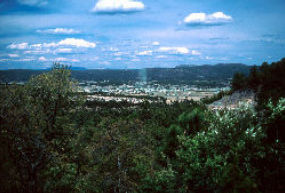 |
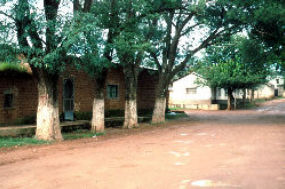 |
| Yécora is in a grassy valley at 1530 m elevation that lies at the east base of the Mesa del Campanero. |
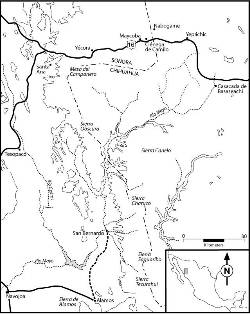 In 1673 the Jesuit missionary Alonso Victoria founded the settlement of San Idelfonso de Yécora in eastern Sonora. In 1916, it was designated as the seat of the Municipio (= County) de Yécora by Governor Adolfo de la Huerta. It is located at an elevation of 1550 m in a grassland valley surrounded by pine-oak forest slopes. The Municipio has an area of 3312 km2 and ranges in elevation from 460 m along Arroyo Tepoca near Curea to 2240 m on the highest point of Mesa del Campanero in an airline distance of 25 km, an elevational gradient of 71.2 m\km. Mesa del Campanero is one of the highest points in eastern Sonora. The Municipio from 109°17'W west of Tepoca to 108°31'W near the Chihuahua border is 76 km wide by air and 145 kilometers along MEX 16. Principal towns are Tepoca, Yécora, Maycoba, and El Kípor along the highway and Agua Blanca, La Concepción, Curea, Guadalupe Tayopa, La Quema, San Nicolás, Santa Ana, Santa Rosa, and La Trinidad along secondary roads. Most of the area is in the Río Yaqui drainage. Only a very small area near El Bordo on the west slope of Mesa del Campanero drains to the Río Mayo. In 1673 the Jesuit missionary Alonso Victoria founded the settlement of San Idelfonso de Yécora in eastern Sonora. In 1916, it was designated as the seat of the Municipio (= County) de Yécora by Governor Adolfo de la Huerta. It is located at an elevation of 1550 m in a grassland valley surrounded by pine-oak forest slopes. The Municipio has an area of 3312 km2 and ranges in elevation from 460 m along Arroyo Tepoca near Curea to 2240 m on the highest point of Mesa del Campanero in an airline distance of 25 km, an elevational gradient of 71.2 m\km. Mesa del Campanero is one of the highest points in eastern Sonora. The Municipio from 109°17'W west of Tepoca to 108°31'W near the Chihuahua border is 76 km wide by air and 145 kilometers along MEX 16. Principal towns are Tepoca, Yécora, Maycoba, and El Kípor along the highway and Agua Blanca, La Concepción, Curea, Guadalupe Tayopa, La Quema, San Nicolás, Santa Ana, Santa Rosa, and La Trinidad along secondary roads. Most of the area is in the Río Yaqui drainage. Only a very small area near El Bordo on the west slope of Mesa del Campanero drains to the Río Mayo.
Since 1995 Tom Van Devender and Ana Lilia Reina have been studying the plants of the Municipio de Yécora which is located in the northern portion of the broad Río Mayo Region studied by Gentry (1942) and Martin et al. (1998). The flora with a total of 1672 taxa in 122 families is one of the richest known to us in Mexico (Reina G. et al. 1999). A taxon is any taxonomic unit. Here it reflects the number of species plus additional varieties and subspecies.
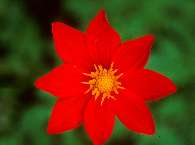
Gallery of composites |
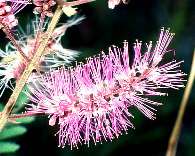
Legume gallery |
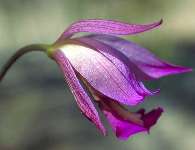
Gallery of other Yécora plants |
The families with the greatest number of taxa are the Asteraceae (Compositae, 251), Poaceae (Gramineae, 188), Fabaceae (Leguminosae, 177), and Euphorbiaceae (57). This is typical of temperate floras and unlike tropical deciduous forests which have greater numbers of legumes. (Tropical vegetation occurs below 1000 m in the Municipio de Yécora.) The most numerous genera are Muhlenbergia (34, a grass), Euphorbia (31, spurges), Dalea (22), Quercus (14 plus 6 hybrids, oaks), Cheilanthes (16, ferns), and Salvia (20, mints). Other interesting plants in the area include milkweeds, cacti, begonias (Begonia spp.), perico cimarrón (Tigridia pavoniana), wild hydrangea (Hydrangea seemannii), lilies), agaves, and orchids. Over 30 taxonomic specialists helped with species identifications and specimens have been deposited into many herbaria in the United States and Mexico.
John and Charlotte Reeder of the University of Arizona, Van Devender, and Reina studied the grasses of the Municipio de Yécora and their distribution and abundance in the various vegetation types in the Municipio (Van Devender et al in press). A total of 188 grass taxa in 60 genera were recorded. With additional species expected in the Municipio, the potential total of 222 taxa reflects one of the highest grass diversities in Mexico. The number of grass taxa increased with elevation and rainfall. Many (43%) of the grass taxa were restricted to single vegetation types, most commonly in tropical deciduous or pine-oak forests. Annuals were found to be less common than perennials. Most of the grasses are native species (86%). The only introduced species that are ecological threats are buffelgrass (Pennisetum ciliare) in the tropical lowlands and Natal grass (Melinis repens) in grassland and oak woodland.
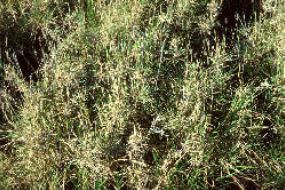
Buffelgrass (Pennisetum ciliare) is probably the greatest invasive exotic plant threat to Arizona Upland Sonoran Desert and thornscrub communities. It dominates huge areas of Sonora and is still expanding rapidly. See the buffelgrass website. |
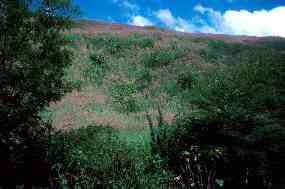
Natal grass or zacate rosado (Melinis repens, Rhynchelytrum r.) has been here many decades as an uncommon plant. During the last decade it has expanded explosively. |
References
Gentry, H. S. 1942. Río Mayo plants. A study of the flora and vegetation of the Valley of the Río
Mayo, Sonora. Carnegie Institution of Washington Publication 527. Carnegie Institution Martin, P. S., D. Yetman, M. Fishbein, P. Jenkins, T. R. Van Devender, and R. K. Wilson. 1998. Gentry's Río Mayo plants. The tropical deciduous forest and environs of northwest Mexico. University of Arizona Press, Tucson, AZ. Reina G., A. L., T. R. Van Devender, W. Trauba, and A. Búrquez M. 1999. Caminos de Yécora. Notes on the vegetation and flora of Yécora, Sonora. Pp. 137-144 in D. Vasquez del Castillo, M. Ortega N., C. A. Yocupicio C. (eds.), Memorias: symposium internacional sobre la utilización y aprovechamiento de la flora silvestre de zonas arida. Departamento de Investigaciones Científicas y Tecnológicas de la Universidad de Sonora, Hermosillo, Sonora, Mexico. Van Devender, T. R., J. R. Reeder, C. G. Reeder, and A. L. Reina G. In press. Distribution and diversity of grasses in the Yécora region of the Sierra Madre Occidental of eastern Sonora, Mexico. In J.-L. E. Cartron, G. Ceballos, and R. S. Felger (eds.), Biodiversity, ecosystems, and conservation in northern Mexico. Oxford University Press, New York, NY.
Retrieved from the Arizona-Sonora Desert Museum web site on 01-12-2026
https://www.desertmuseum.org/programs/yecora_flora.php
|







